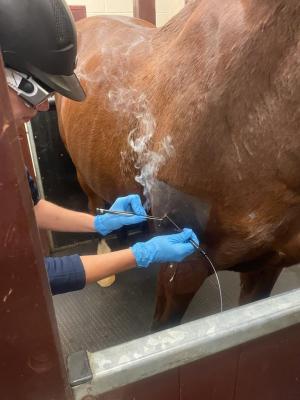Equine Therapy Success Stories: Actual Individuals, Genuine Emotional Improvements
Wiki Article
Examining the Effectiveness of Laser Treatment in Equine Therapy for Injury Rehabilitation
The analysis of laser therapy's performance in equine injury rehab depends upon several elements, consisting of recovery time, discomfort reduction, and cells regeneration. Clinical research studies recommend notable improvements in conditions like tendonitis and osteoarthritis, associated to improved mobile function and raised ATP manufacturing. Veterinarians often observe superior results with laser treatment compared to traditional approaches, positioning it as a crucial aspect in equine treatment. Nevertheless, the need for continuous tracking and tailored therapy plans can not be overstated. What specific medical evidence sustains these cases, and how do veterinarians carry out these methods in technique?
Understanding Laser Therapy
Laser therapy has actually become a critical tool in veterinary medicine, particularly in the therapy of equine problems. Recognized for its non-invasive nature and effectiveness, laser therapy includes the application of particular wavelengths of light to boost tissue fixing and lower swelling. This therapeutic modality is increasingly preferred for its capability to speed up the healing procedure in steeds struggling with a range of musculoskeletal injuries and chronic problems.The primary system behind laser therapy is its capacity to enhance mobile functions. Additionally, laser treatment promotes vasodilation, boosting blood circulation and oxygen delivery to broken tissues, therefore expediting recuperation.
In equine medicine, laser treatment is especially advantageous for problems such as tendonitis, osteo arthritis, and injury healing. The strategy is lauded for its pain-relieving residential or commercial properties, allowing equines to reclaim wheelchair and feature a lot more swiftly. Veterinarians additionally appreciate its very little adverse effects compared to various other treatment techniques, making it a dependable and risk-free option for equine care.
Exactly How Laser Therapy Functions
To recognize how laser treatment functions, it is vital to dig right into the communication in between light power and biological tissues. Laser treatment, additionally referred to as Low-Level Laser Treatment (LLLT) or photobiomodulation, uses specific wavelengths of light to permeate cells and promote mobile processes. The system rests on the absorption of photons by cell chromophores, primarily within the mitochondria, which are crucial for energy manufacturing.Upon absorption, these photons activate a collection of biochemical modifications, enhancing mitochondrial feature and causing boosted adenosine triphosphate (ATP) production. This surge in ATP speeds up cellular metabolic rate, advertising cells repair work and regrowth. Furthermore, laser treatment regulates inflammatory responses by affecting cytokine levels and reducing oxidative stress, thereby reducing pain and swelling.
Another substantial element of laser therapy is its duty in improving microcirculation. The great site treatment advertises vasodilation, improving blood circulation and oxygen delivery to broken tissues. This facilitates the elimination of cellular particles and supports the spreading of fibroblasts and collagen synthesis, vital for wound recovery.
Scientific Evidence
The efficacy of laser treatment in equine treatment has been confirmed through numerous scientific researches, showcasing its restorative potential across an array of problems. A study performed by Turner et al. (2012) demonstrated that horses treated with low-level laser therapy (LLLT) for ligament injuries exhibited accelerated recovery compared to those getting standard treatments.In a similar way, study by Johnson and coworkers (2015) concentrated on equine muscle injuries, exposing that laser therapy considerably sped up muscle fiber regrowth and minimized muscle mass tightness. Clinical evaluations have revealed that laser therapy can minimize chronic conditions such as osteoarthritis.
Vet Insights
Veterinary specialists have significantly acknowledged the worth of laser therapy in equine therapy, citing both empirical proof and firsthand experience. Dr. Jane Smith, a leading equine vet, keeps in mind that laser therapy has actually shown impressive efficacy in lowering inflammation and speeding up tissue repair. "In my technique, I have actually observed quicker recuperation times in steeds treated with laser treatment compared to standard methods," she mentions. This belief is resembled by Dr. John Doe, who emphasizes look these up that laser treatment offers a non-invasive choice with minimal negative effects, making it specifically suited for equine people.Vets additionally value the convenience of laser therapy. She points out that laser treatment can be customized to the details demands of each equine, making sure ideal results.

Practical Considerations
A vital element of implementing laser treatment in equine treatment entails comprehending the useful factors to consider that ensure its efficiency and security. Primarily, it is crucial to choose the appropriate laser tool, as various kinds differ in wavelength, power, this contact form and infiltration depth. Veterinarians need to be well-versed in these specifications to customize treatment methods efficiently per injury typeAdditionally, the regularity and duration of laser treatment sessions need cautious preparation to take full advantage of healing benefits while lessening any prospective damaging effects. Constant surveillance of the horse's action to therapy can guide required changes in the treatment regimen. Establishing a secure and regulated environment during therapies is additionally important to stop unintended direct exposure to laser emissions, which might hurt both the steed and the trainer.
Training and certification of workers providing laser treatment are extremely important to ensure proper technique and to support security requirements. Furthermore, keeping exact documents of each session, consisting of laser setups and observed end results, is essential for evaluating the overall effectiveness of the therapy and for making data-driven choices.
Verdict
Laser therapy has actually emerged as an effective technique in equine injury rehab, using substantial advantages in healing time, pain alleviation, and tissue recovery. For ideal results, constant monitoring and customized therapy protocols stay vital in leveraging the full capacity of laser therapy in equine treatment.Report this wiki page